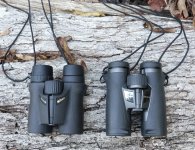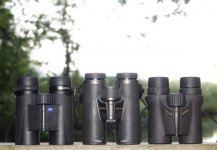-
Welcome to BirdForum, the internet's largest birding community with thousands of members from all over the world. The forums are dedicated to wild birds, birding, binoculars and equipment and all that goes with it.
Please register for an account to take part in the discussions in the forum, post your pictures in the gallery and more.
You are using an out of date browser. It may not display this or other websites correctly.
You should upgrade or use an alternative browser.
You should upgrade or use an alternative browser.
A little time with the Premier 8X32... (1 Viewer)
- Thread starter chill6x6
- Start date
More options
Who Replied?This matches up with some experiences I've had with my Ultravid 7x42. I'm not very good at ID at far distances, so I don't go out of my way looking at specs too far out like hawks way up high. Plus, it's a lower power bino and far away birds can look like specs sometimes anyway. I have noticed a few times colorization seems a touch off with these far distance birds, but when they get closer I'll ID the bird and realize the color did not look quite accurate at the far distance. I'm not talking about color fringing, but just what you mentioned. Close and middle distance birds seem to have accurate color rendering and look amazing through the Uvid Plus. Perhaps if I were to think about getting a 10x for distant birds like for Hawk watching I may go for Zeiss, Swaro or Nikon instead. For the viewing distances I prefer (am comfortable with) the Leica is just wonderful.
GG
I recommend that you get Jerry Liguori's book," HAWKS at a distance: Identification of Migrant Raptors."
Read the forward by Pete Dunne. Then go to the introduction to familiarize yourself with the book and learn how to use it. Liguori recommends using only binoculars. (p.8) He has used Zeiss 7x42 binoculars for many years because of their wide FOV. None the less he also insists that the binoculars be high quality binoculars no matter their power.
Your Leica 7x42 Ultravid will do just fine for watching "Hawks At A Distance" with its 8º FOV.:t:
The book is full of great photographs of all of the North American Hawks, Eagles, Vultures and Falcons. On matters of coloration there is a discussion of plumage on all of the raptors.
ISBN 978-0-691-12559-5 Princeton Press Princeton.edu Quality Paperback. 190pp.
Bob
Last edited:
A2GG
Beth

GG
I recommend that you get Jerry Liguori's book," HAWKS at a distance: Identification of Migrant Raptors."
Read the forward by Pete Dunne and then familiarize yourself with the book. On page 8 he discusses optics for hawk watching. He recommends using only binoculars. He has used Zeiss 7x42 binoculars for many years because of their wide FOV. None the less he also insists that they be high quality binoculars no matter their power.
Your Leica 7x42 Ultravid will do just fine with its 8º FOV.:t:
ISBN 978-0-691-12559-5 Princeton Press Princeton.edu Quality Paperback.
Bob
Hey Bob,
I actually have that book already ... it's good and I have used it several times to help me with ID. I have it ready for when I need it and think it's well done. I'm just rubbish at Hawks high up in general, but still hope to get better at ID (of all birds). I think someday if I can retire I'll have more time to put into building my ID skills up. I tend to not look high up like other birders and naturally tend to look in trees, scrub, etc.
For instance, I met a lady at this one spot last Sunday who also had a 7x (classic Zeiss Dialyt) and she told me to look up as there was a Hawk soaring high above. I would never have noticed, but she was scanning the skies. We think it was a Cooper's , but agreed we're both rubbish at far distance ID.
Hey Bob,
I actually have that book already ... it's good and I have used it several times to help me with ID. I have it ready for when I need it and think it's well done. I'm just rubbish at Hawks high up in general, but still hope to get better at ID (of all birds). I think someday if I can retire I'll have more time to put into building my ID skills up. I tend to not look high up like other birders and naturally tend to look in trees, scrub, etc.
For instance, I met a lady at this one spot last Sunday who also had a 7x (classic Zeiss Dialyt) and she told me to look up as there was a Hawk soaring high above. I would never have noticed, but she was scanning the skies. We think it was a Cooper's , but agreed we're both rubbish at far distance ID.
Hi GG!
I'm glad you have the book. It's not a big book and should be easy to carry around during fall migration. Then you could look through it when you are taking a break.
Bob
On most Hawk Watching places you just sit there and look up scanning the sky anyway!
So a little more birding with the Premier 8X32...I started at almost exactly 7AM...quit about 1130.
I like it....I like it a LOT. Very user-friendly with a huge sweet-spot. Eye placement is very forgiving and among the best for 8X32s. For being to chubby....very instinctive...EASY to find the birds. Nice to still see prothonotary warblers and summer tanagers around. LOTS of red-headed woodpeckers.
Chromatic aberration.... At the end of my birding trip I drove down to the docks on the Tennessee River basically to look at sailboat masts/guy-wires. I brought some competition too....namely a Conquest HD and EDG both 8X32s. None of the three were perfect but the EDG is the best of the three. No surprise. To my eyes the Premier was a little better in this regard than the Conquest HD....Conquest HD>Premier>EDG. So there's that.
Let me add that I felt well equipped with the Nikon Premier 8X32! I certainly felt no need to swap for one of the other two 8X32s I had readily available in the truck. This is absolutely plenty of binocular to be considered as one's primary birding binocular.
I kinda sense a duel between it and the Conquest HD.
I like it....I like it a LOT. Very user-friendly with a huge sweet-spot. Eye placement is very forgiving and among the best for 8X32s. For being to chubby....very instinctive...EASY to find the birds. Nice to still see prothonotary warblers and summer tanagers around. LOTS of red-headed woodpeckers.
Chromatic aberration.... At the end of my birding trip I drove down to the docks on the Tennessee River basically to look at sailboat masts/guy-wires. I brought some competition too....namely a Conquest HD and EDG both 8X32s. None of the three were perfect but the EDG is the best of the three. No surprise. To my eyes the Premier was a little better in this regard than the Conquest HD....Conquest HD>Premier>EDG. So there's that.
Let me add that I felt well equipped with the Nikon Premier 8X32! I certainly felt no need to swap for one of the other two 8X32s I had readily available in the truck. This is absolutely plenty of binocular to be considered as one's primary birding binocular.
I kinda sense a duel between it and the Conquest HD.
Attachments
james holdsworth
Consulting Biologist
You're going to see detrimental CA when skies are gray and overcast. Trying hawk-watching in these conditions - you would be surprised just how instructive it is, in terms of sussing out objectionable CA.
... I have noticed a few times colorization seems a touch off with these far distance birds, but when they get closer I'll ID the bird and realize the color did not look quite accurate at the far distance. I'm not talking about color fringing, but just what you mentioned. Close and middle distance birds seem to have accurate color rendering and look amazing through the Uvid Plus...
I've noticed something similar with my older (single coated) binoculars - especially in anything less than sunlit conditions, the colours of distant buildings and trees etc appear more washed out than when using more modern binoculars. I think it must be something to do with more modern coatings increasing contrast and offering better light transmission?
Incidentally, I pretty much exclusively observe raptors (totally suck at trying to find birds in brush!) and... if your bird is close enough for colour to be seen, it's not all that far away! A lot of my viewing is looking at tiny distant silhouettes, trying to figure if what I'm looking at is what I'm searching for, and things like general shape, proportions and manner of flight can provide the clues you need when a bird is far beyond the range at which any colour can be distinguished. Each of the diffent raptor species here is fairly distinct, although I suppose we are fortunate (?) not to have the large number of different raptor species you might encounter in the States, including members of the same family that can appear very similar (sharp-shinned vs Cooper's hawks must be quite tricky). I've tried 7x for this job and find that although the wide field of view of something like the 7x42 Dialyt is great for picking up birds passing within range, I need more magnification to help me follow my target species around after it's been found. I have been using an old 10x50 quite a bit and, although distant colours get washed out as noted earlier, my impression after having used this and other single coated porros is that older binoculars can still control chromatic aberration quite well. I gather leaded glass was used back in the day for similar reasons as today's ED glass.
Grey and overcast is when you really see CA and white skies also.You're going to see detrimental CA when skies are gray and overcast. Trying hawk-watching in these conditions - you would be surprised just how instructive it is, in terms of sussing out objectionable CA.
I have been using an old 10x50 quite a bit and, although distant colours get washed out as noted earlier, my impression after having used this and other single coated porros is that older binoculars can still control chromatic aberration quite well. I gather leaded glass was used back in the day for similar reasons as today's ED glass.
I believe that Henry Link stated that some old Porro binoculars with cemented doublets using traditional crown and flint glasses were better colour corrected than some roof prism binoculars with internal focussing. If the latter have a single-element focussing lens and are also designed to provide a very short close focus (long travel or high power), then the colour correction of the objective is compromised.
Leaded glass is flint glass, i.e. it has a high refractive index and a low Abbe number (high dispersion) and is or was used in the negative elements of an objective.
Fluorite (calcium fluoride crystal) and so-called ED, HD or SD glasses have low refractive indices and high Abbe numbers (low dispersion) and are used in the positive elements of many modern objectives.
John
Leaded glass is flint glass, i.e. it has a high refractive index and a low Abbe number (high dispersion) and is or was used in the negative elements of an objective.
Fluorite (calcium fluoride crystal) and so-called ED, HD or SD glasses have low refractive indices and high Abbe numbers (low dispersion) and are used in the positive elements of many modern objectives.
John
Hi John - thanks for clearing up something that had me scratching my head ever since I realized that leaded glass had a high refractive index/high dispersion and yet was used for the same purpose as ED/low dispersion!
I remember some threads discussing the optical issues arising from internal focusing solutions. Internal focusing is great from the point of view of weather resistance and functionality (avoiding the bellows effect of external focusing) but as with roof prism binoculars, that practicality seems to be at the price of optical issues that require quite costly solutions!
Best regards
patudo

I have an old pair of 8x32 HGs as one of too many backup bins.
One negative - the focus wheel stiffness corresponds to temp. Becomes quite stiff somewhere around 30F.
One negative - the focus wheel stiffness corresponds to temp. Becomes quite stiff somewhere around 30F.
Similar threads
- Replies
- 22
- Views
- 3K
Users who are viewing this thread
Total: 2 (members: 0, guests: 2)








